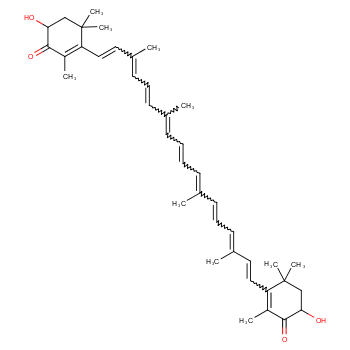 |
Astaxanthin, a keto-carotenoid, is a lipid-soluble pigment that belongs to the terpenes class of chemical compounds. It is classified as a xanthophyll and is known for its red-orange color. Astaxanthin is also an antioxidant, thanks to its conjugated double bonds.

Figure 1: Appearance of Astaxanthin.
Astaxanthin is synthesized through a complex biosynthesis process. It starts with the combination of isopentenyl pyrophosphate (IPP) and dimethylallyl pyrophosphate (DMAPP) to form geranylgeranyl pyrophosphate (GGPP). This compound then undergoes several enzymatic reactions to eventually produce astaxanthin.
Astaxanthin is widely used as a dietary supplement and feed supplement for various animals, including salmon, crabs, shrimp, chickens, and egg production. It is also employed as a food colorant. However, its potential health benefits for humans are still under preliminary research.
Due to the high market price and limited production methods, alternative fermentation production systems for astaxanthin are being explored. Metabolic engineering of bacteria, such as Escherichia coli, has shown promising results in efficient astaxanthin production. However, a bioprocess approach that considers fermentation conditions, economics, and downstream processing is necessary for industrial-scale production.
[1] Margalith, P. Z. (1999). "Production of ketocarotenoids by microalgae". Applied Microbiology and Biotechnology. 51 (4): 431–8. doi:10.1007/s002530051413. PMID 10341427.
[2] Barredo, Jose; García-Estrada, Carlos; Kosalkova, Katarina; Barreiro, Carlos (2017-07-30). "Biosynthesis of Astaxanthin as a Main Carotenoid in the Heterobasidiomycetous Yeast Xanthophyllomyces dendrorhous". Journal of Fungi. 3 (3): 44. doi:10.3390/jof3030044. ISSN 2309-608X. PMC 5715937. PMID 29371561.
[3] Ambati, Ranga Rao; Phang, Siew-Moi; Ravi, Sarada; Aswathanarayana, Ravishankar Gokare (2014-01-07). "Astaxanthin: Sources, Extraction, Stability, Biological Activities and Its Commercial Applications—A Review". Marine Drugs. 12 (1): 128–152. doi:10.3390/md12010128. PMC 3917265. PMID 24402174.
[4] Scaife, M. A.; Burja, A. M.; Wright, P. C. (2009). "Characterization of cyanobacterial β-carotene ketolase and hydroxylase genes in Escherichia coli, and their application for astaxanthin biosynthesis". Biotechnology and Bioengineering. 103 (5): 944–955. doi:10.1002/bit.22330. PMID 19365869.
 |